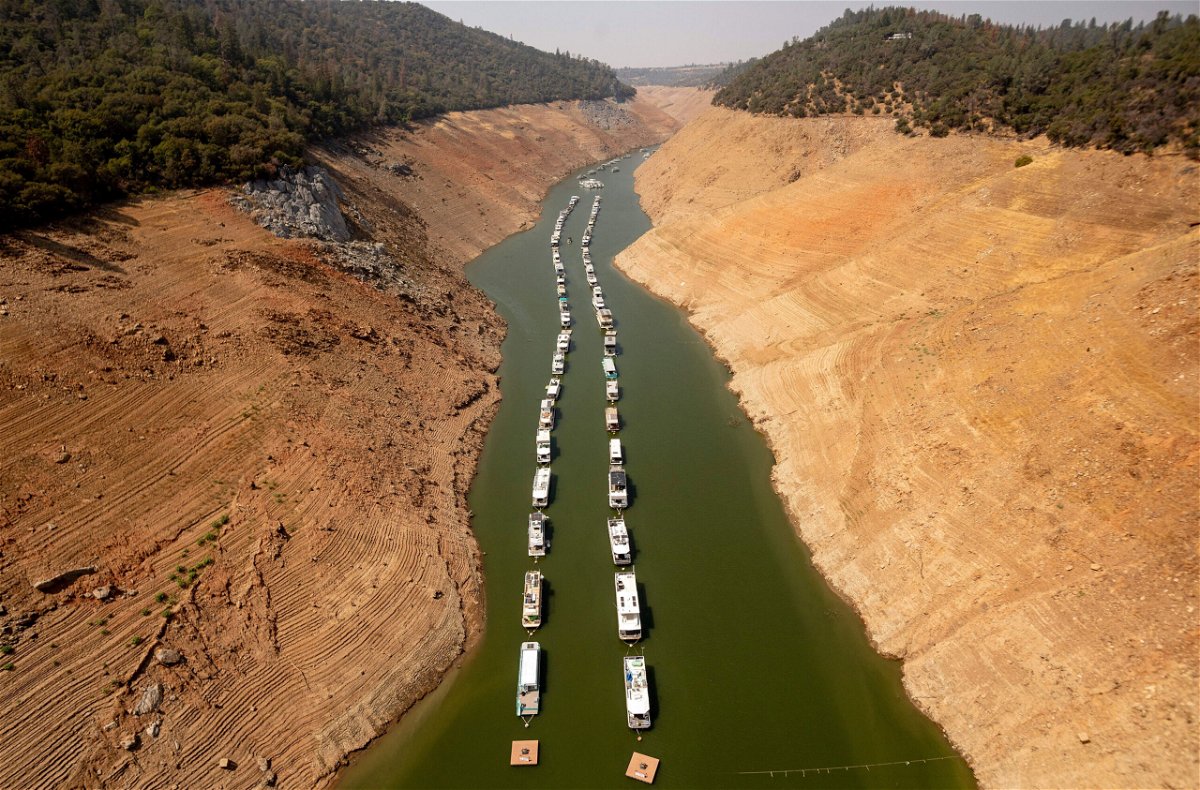After one of the driest years on record, it will take multiple years for some states to recover

Houseboats sit in a narrow section of water in a depleted Lake Oroville in Oroville
By Allison Chinchar, CNN Meteorologist
Record drought, wildfires, and water shortages have beleaguered the western US, and the forecast is not much brighter. A new water year began Friday, resetting the clock for many states who are hopeful to start anew and see better results.
The water year is defined as October 1 – September 30. The 12-month period was selected because it is an ideal reset period in terms of the US water cycle, and October 1 presented a good natural break for many regions of the US. It is after monsoon rains peak in the Southwest, before the bulk of snow begins for the Northeast and Midwest, and is when tropical cyclones wind down (traditionally) for the Southeast.
The end of the water year was quite good for some locations. Tucson, Arizona had its third-wettest monsoon on record. From June 15 through September 30, Tucson picked up a whopping 12.79″ of rain. Even more recently, rainfall in Washington state was more than plentiful in September. Seattle picked up more than 3 inches of rain which is 188% of normal. Nearby Bellingham picked up more than 4 inches of rain, making its fourth-wettest September on record.
While the rain was supremely helpful in eliminating wildfires in both Arizona and Washington, unfortunately, it was not enough enough to entirely eliminate drought conditions for those states.
“To offset the long-term drought across the southwest, we would need multiple years of both a wet winter and wet monsoon season,” said Chelsea Peters, a meteorologist for the National Weather Service (NWS) in Las Vegas.
Most western states are similar, in which one good season of rain does not make up for several years of rain deficits.
For a state like California, the reality is all too familiar.
California’s long dry stretch
Downtown Sacramento has officially gone 196 days without measurable rain, which breaks the record for the longest dry streak, set way back in 1880.
Bakersfield’s 2020-2021 water year was the fifth-driest on record. Precipitation records there date back to 1892.
Downtown San Francisco’s most recent water year ended as the second-driest on record, and record keeping goes back over 170 years.
The problem for many areas is they have not had just one bad year.
“Total precipitation across the region was abysmal for the second consecutive year,” the NWS in Sacramento said.
San Francisco is in a similar situation since the 2019-2020 water year was the 12th-driest on record.
While every bit of rain helps in a drought, multiple years of low precipitation can compound water shortages.
A new report from the National Oceanic and Atmospheric Administration (NOAA) highlights the widespread impacts from decades of water issues.
“This exceptional drought—marked by massive water shortages, destructive wildfires, emergency declarations, and the first ever water delivery shortfall among the states sharing the Colorado River—punctuates a two-decade warm and dry period that has baked the Southwest,” the report stated.
And it is not just the Colorado River. From California to Colorado rivers, lakes, and reservoirs sat at extremely low levels, and in some cases record low levels
“Several seasons (or years) of above-average rain and high elevation snow are needed to refill the rivers, soils, and reservoirs that more than 60 million people depend on for their water, livelihoods, food, power, and recreation,” the report indicated.
What is needed for California and other western states is multiple years of surplus rains, but also snow. Snow can have often have a greater impact than rain when it comes to building up the water supply.
Forecast is a mixed bag
Arizona, California, Colorado, Nevada, New Mexico, and Utah have all experienced successive dry and warm winter seasons in 2020 and 2021, along with a failed 2020 summer monsoon.
From January 2020 to August 2021, these states had their lowest precipitation totals on record since at least 1895, as well as the third-highest daily average temperatures.
However, in the short term, the forecast looks good from northern California to North Dakota. The Climate Prediction Center (CPC) forecast 6-14 days out shows above average rainfall estimates.
The concern is the long term forecast because La Nina may become a factor as we head into winter.
The CPC recently issued its three-month outlook products for October through December. Rainfall chances look to be slightly above average for the Pacific Northwest, but quite the opposite from southern California through Colorado.
“Overall, La Nina typically means less precipitation for the Sierra, Great Basin region, and the Mojave Desert, which is bad for the current drought status and the potential for another active fire season next year,” Peters said. “However, the magnitude of the La Nina event will dictate the magnitude of impacts on the winter weather pattern. Considering the current state of ENSO is neutral, La Nina may be weak through at least the early part of the winter season.”
Over the last 20 months above normal temperatures also reduced mountain snowpack and increased evaporation of soil moisture.
That is why the CPC three-month outlook for temperatures is also concerning, because it predicts several western states will have above average temperatures. As a result, increased evaporation could occur over an already-parched area.
The NOAA report also highlights how the drought was exacerbated by human-caused warming.
“With continued warming, the atmospheric demand for soil moisture will continue to increase, making even randomly-occurring low or near-normal precipitation years a potential drought trigger.”
The-CNN-Wire
™ & © 2021 Cable News Network, Inc., a WarnerMedia Company. All rights reserved.